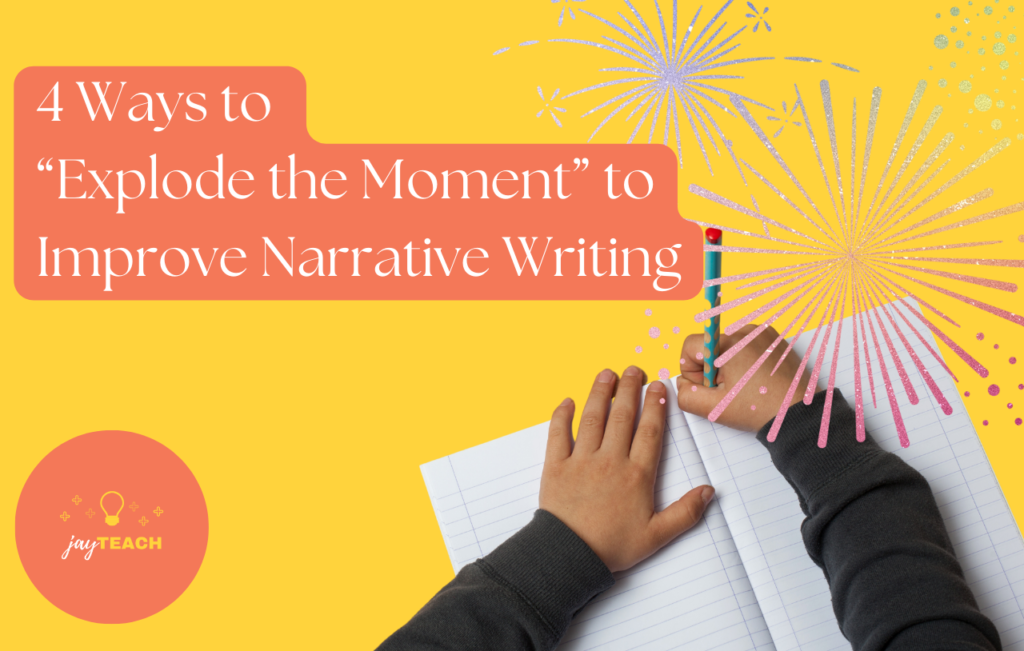Teaching students how to “explode the moment” is one of my all-time favorite parts of teaching writing. If you are here, I imagine you are teaching your students personal narrative writing or small-moment writing techniques and are looking for ways to strengthen student writing. Well, you are in the right place.
What does “explode the moment” mean?
When I saw my students’ writing when teaching the Units of Study by Lucy Calkins, I scoured the internet for ways to teach students how to “stretch a scene” or “tell a story moment-by-moment.” While I found some resources on the topic, I knew I had to create my own systematic lesson. Enter: Explode the Moment.
I typically start this lesson by transforming into an award-winning actor: “You are going to watch me act out a quick scene. Then, you are going to write what happened on your index card.”
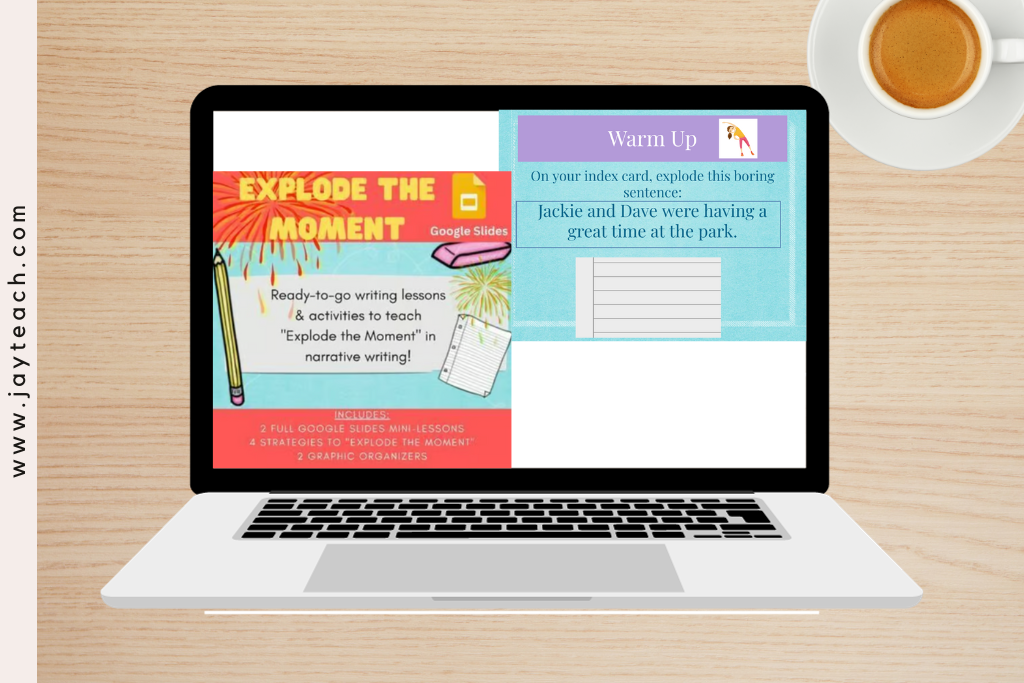
My scene is typically simple. Maybe I enter the classroom looking frustrated, throw my bag down, and let out a big sigh before rummaging through my pencil collection. When the scene is over and it is time for students to write, I typically see something like this: “She walked in the room, threw down her bag, and started looking for pencils. She seemed mad.”
Perfect… just what I was expecting. From here, I introduce my 4 ways to explode the moment. Essentially, I am teaching students how to tell a story moment by moment, inch by inch, bit by bit using descriptive and engaging language.
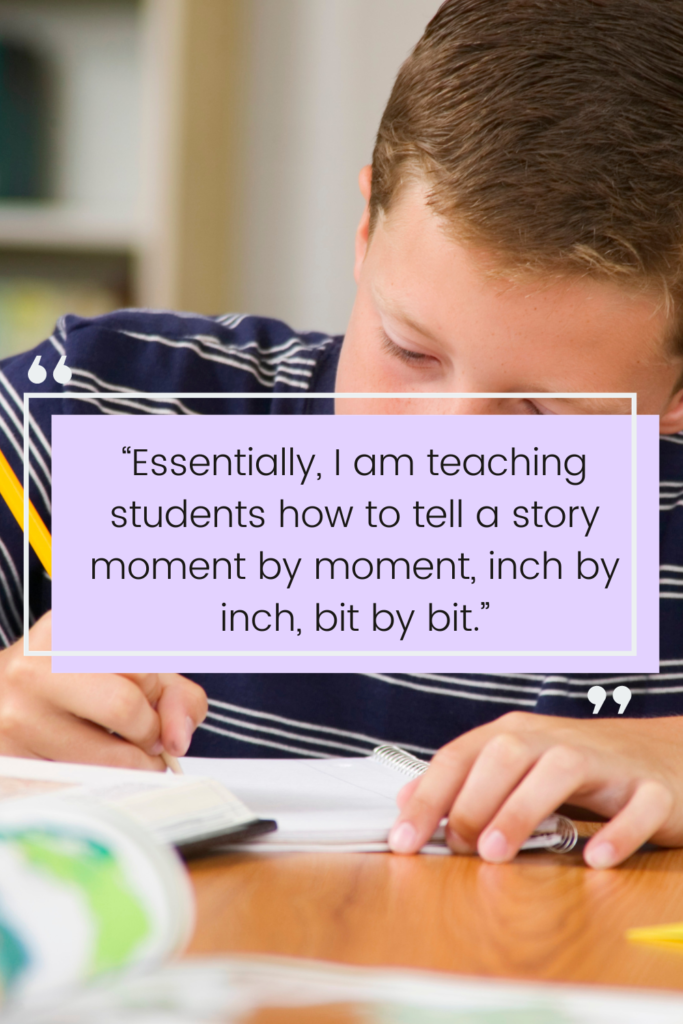
Before we dive into the good stuff, I want to share some of my literacy resources for teaching writing in a systematic, fun way. Specifically, my narrative writing unit plan has saved teachers hundreds of collective hours of prep!
Now, let’s get into the strategies…
Explode the Moment Strategy #1: Add Sensory Details
Teaching sensory details is one of my favorite writing crafts to incorporate into my lessons. I typically introduce it using objects that can appeal to the five senses. Maybe a sticky chunk of slime or a delicious multi-layered cookie. I might have students get into groups and without looking, describe each object to his or her partner using descriptive language. I am always surprised at the increase in student vocabulary when implementing such lessons.
Once they have an understanding of sensory language, I teach it as the first way to “explode the moment.” We quickly review the five senses: sight, smell, touch, sound, and taste. I model taking a boring moment: “I ate breakfast with my family,” and transforming it by using some of the senses: “The sweet maple smell of pancakes filled the room. Crunch! The crisp taste of bacon made my tastebuds dance.”
Not only does this showcase sensory detail, but it teaches the concept of stretching our writing. As a bonus, I ask students to devise alternative ways to add the senses to this moment. “The more senses the better!”
Explode the Moment Strategy #2: Describe the Setting
At this point in the year, students have an understanding of what “setting” means. Strategy # 2 takes the concept of setting and builds upon it. The second way to “explode the moment” is by describing the setting using imagery. I often begin by having students close their eyes and imagine their favorite place.
Then, they can describe that place to a classmate. Their partner has to guess the place based on the descriptive clues. I also model this strategy by transforming a boring moment: “It was sunny outside,” into one with more descriptive imagery: “The sun shone on my skin like a warm pancake. As I walked to the cobblestone driveway, I felt the wet, dewy grass under my feet. The trees were vibrant and the blue sky was spotless.”
Notice I threw in a simile too! I love to include alternative writing crafts in my examples as previews of future lessons.
Explode the Moment Strategy #3: Use “Show, Don’t Tell”
Next up is probably the writing craft that takes the most practice for my students. At this point, I have already taught a mini-lesson on “Show Don’t Tell” specifically, so they have a baseline understanding of what it means. Essentially, this writing craft asks the question, “How can we SHOW a character’s emotion or trait instead of TELLING it?” I like to start with role-playing: “Show me what anger looks like. Oh wow! I see Jacob furrowing his brow, clenching his fists, and breathing heavily!”
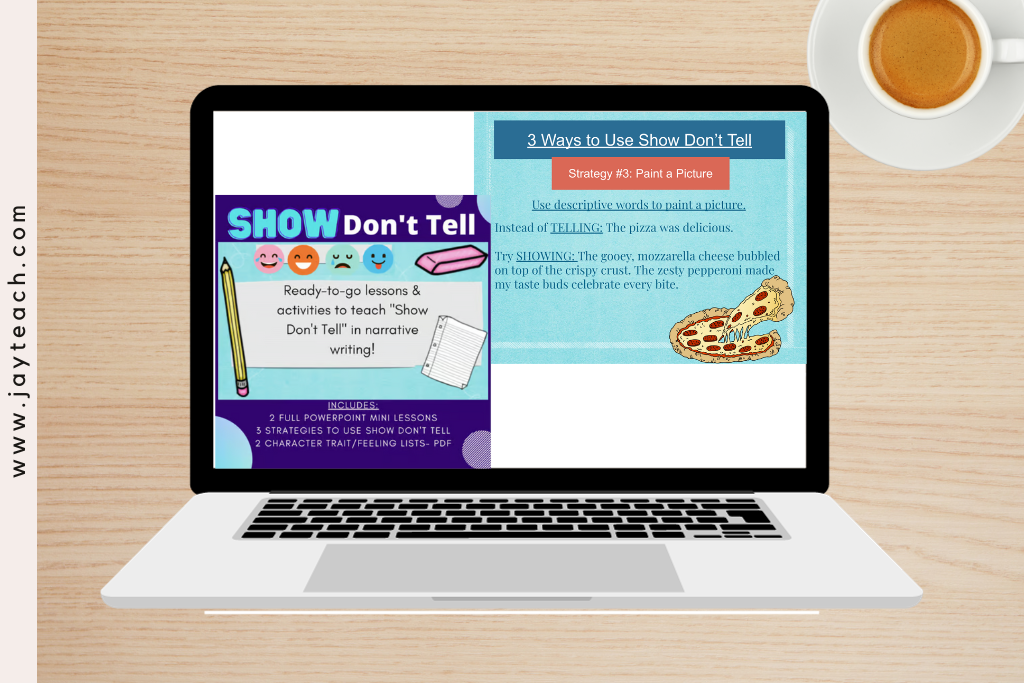
Next, I model transforming a boring moment: “I was so excited to see the play” and using details to SHOW excitement without point blank saying it: “The butterflies in my stomach were like an untrained dog, running around in my belly. I squeezed my hands together, jumped off the couch, and yelled, ‘I’m ready!’”
Another way to teach this concept which appears in my Show Don’t Tell lesson, is having students choose an emotion or character trait from a list and without telling their partner, write a scene that SHOWS the emotion or trait. If they have strong descriptive writing and lots of details, their partner should be able to guess– or at least come close! My students LOVE this activity.
Explode the Moment Strategy #4: Add Inner Thought
My final strategy for teaching “explode the moment” to students is to teach the concept of inner thought. How can we get inside the mind of our main character? What are they thinking and feeling through this whole story?
I usually start with a fun fact about how many thoughts the average human has in a day. Then, I model transforming a boring moment: “Ryan was frustrated that his sister ate the last cookie,” into something with an inner thought: “Ryan clenched his fists and let out a giant sigh. She always does this to me.”
Adding inner thought is a fun way to explode any moment!
Now of course we know that all good writing is composed of a mixture of writing crafts, which is the ultimate goal. With that said, I have found that concretely teaching these four strategies is a wonderful starting point.
After teaching this lesson, it is time for students to explode a moment using my “Explode the Moment Graphic Organizer.” I have to tell you– this is one of my most popular, all-time favorite organizers.
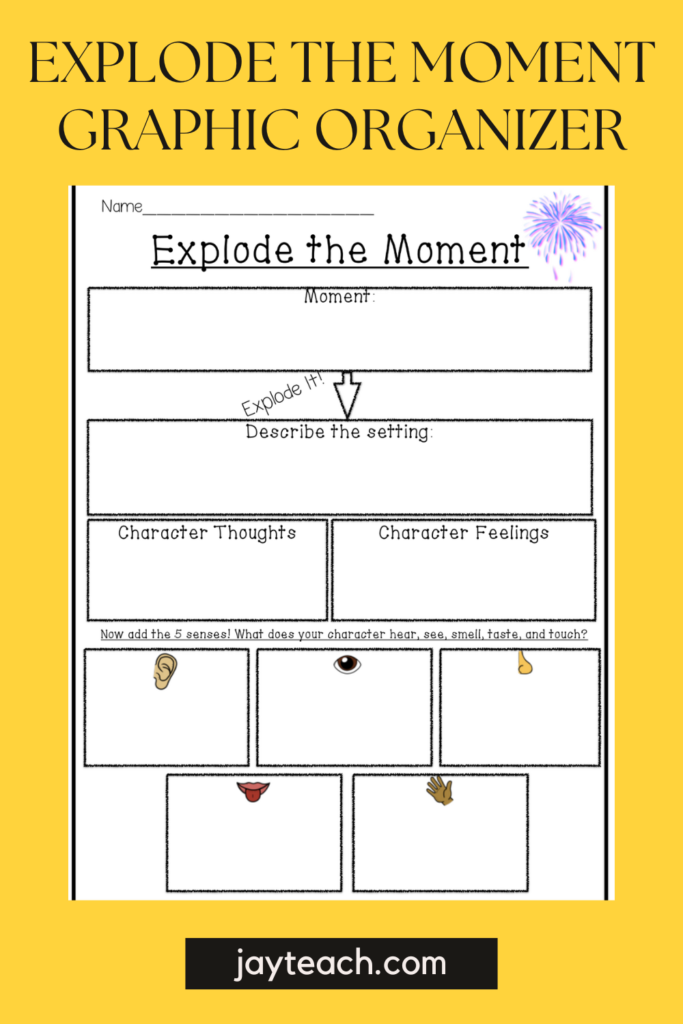
I actually had a student say, “Wow! I didn’t know you could write so much just from one moment.” This graphic organizer takes all of the individual strategies and compiles them into one activity. Here’s how it works:
Students choose one moment (typically one sentence) from their existing writing to “explode.” Next, they fill in some details including the five senses, the setting, what the character was thinking, and what the character was feeling. Finally, they take all of this information and create a narrative version of it. One sentence usually becomes one page of writing and the students’ minds are blown!
I hope these strategies to explode the moment are helpful to you and your students!
You may also be interested in:
3 Time-Saving Ways to Teach the Units of Study by Lucy Calkins

